What do individual ETF investors really want?
Share
The global Exchange Traded Fund (ETF) market keeps growing. In the last decade, ETF assets have more than quadrupled to reach $11.6 trillion by December 20231. As the popularity of these investments show no sign of abating, Amundi took the opportunity to get under the skin of individual or private ETF investors (also known as retail investors) in our recent global retail investor survey. These products have become increasingly appealing to retail investors. Below are four things that you might not know about ETF investors.
ETFs are a key entry point into retail investing
Reflecting the growth in the ETF market over recent years, our survey data below shows that 31% of retail investors globally hold one of these products within their portfolio. This peaks at 49% among those in Germany and 42% among those in Singapore, falling to a more modest 17% in France and 16% in Poland.
However, our findings also demonstrate that, for many, ETFs act as a crucial first step into the world of investing – cited by more than one-in-ten retail investors globally as the first investment that they ever held.
However, this does not look the same across all markets. Those in the Nordics and Germany are most likely to have chosen an ETF as their first ever investment, while those in France and Poland are significantly less likely.
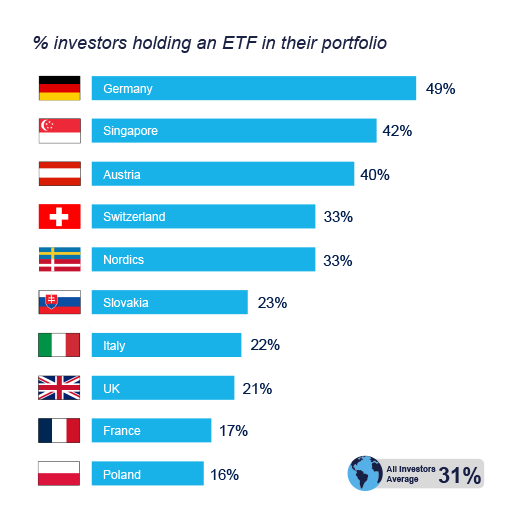

Source: Amundi: Decoding Digital Investment
ETF investors have a positive outlook
Among those retail investors that hold an ETF, a mean average of 35% of their entire portfolio is currently invested in this type of investment. This is highest among younger investors and those earlier in their accumulation journey, according to the survey. However, there is significant scope for distributors and fund managers to grow this market.
Our findings show that ETF investors hold a more positive market sentiment than the average retail investor – a mindset that can present opportunities for engagement. More than one-in-four ETF investors (28%) expect to increase the amount that they invest over the coming year, compared to only a more modest one-in-five (20%) among all retail investors.
Furthermore, of those already holding or aware of ETFs, the survey shows that nine-in-ten (90%) feel it is either very or fairly likely that they will consider further ETF investments in the future – with our data suggesting that this opportunity is stronger in Germany and among wealthier male investors generally.
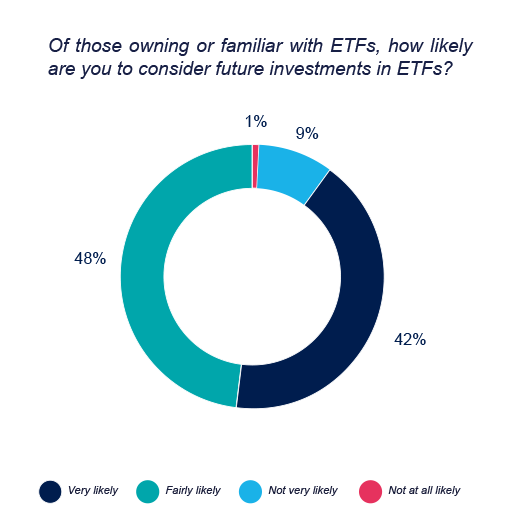
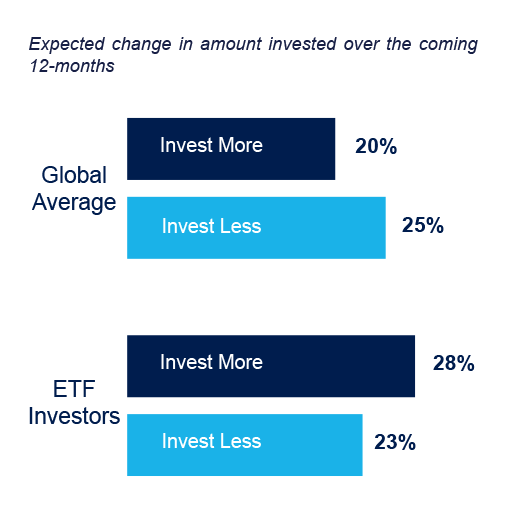
Source: Amundi: Decoding Digital Investment
ETF investors are inherently more confident and digitally enabled
One of the key factors that we believe has helped to drive the growth in the ETF market has been the development of digital platforms – making low cost, flexible and comparatively uncomplicated investments far more accessible to confident self-service investors.
Investors who are more confident that they are making the right saving and investment decisions feel more empowered to explore and use digital investment platforms like share trading apps, digital banks, neobanks and self-service investment platforms.
Our findings strongly support this premise – with ETF investors globally both significantly more confident than the average investor that they are making the right saving and investment decisions and being far more likely to hold investments on digital platforms.

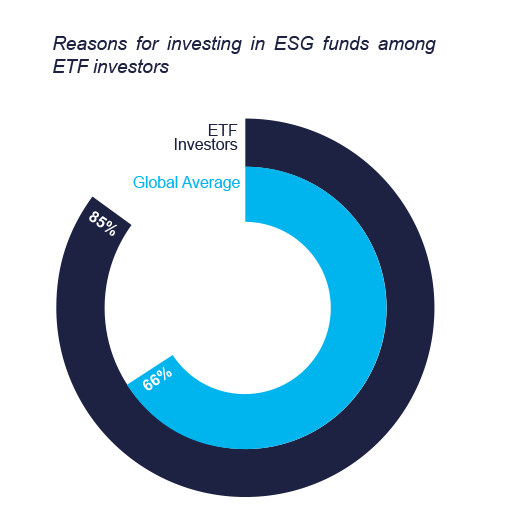
Source: Amundi: Decoding Digital Investment
ETF investors are more ESG-focused
The more positive sentiment and the higher levels of digital engagement among ETF investors looks to have a knock-on effect on their likelihood to invest through an Environmental, Social and Governance (ESG) lens.
According to our findings in our study, 71% of ETF investors hold ESG investments, either independently seeking them or upon advice. This is significantly higher than the 56% among all investors globally.
Furthermore, ETF investors are more likely to state that they intend to increase the proportion of their portfolio that is invested through ESG funds (70% vs. 62% overall) – with the key drivers behind this being a desire to have a positive impact (54%) and a belief it is the right thing to do (51%). That said, 45% of ETF investors that own ESG funds also do so in anticipation of better longer-term performance.
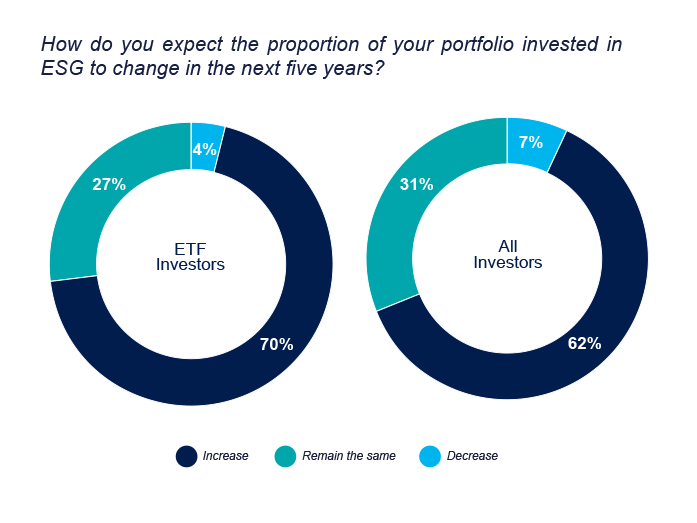

Source: Amundi: Decoding Digital Investment
All in all, our survey findings demonstrate that, for distributors, it could make sense to target ETF investors – particularly via digital platforms – given their greater levels of appetite for ETFs, but also a whole wider range of investment types.
* The findings in this article are based on the views of 4,186 retail investors surveyed across 11 countries in Europe and Asia. We set quotas by both age and gender to ensure to have a sufficient and robust sample in order to confidently assess differences between demographic groups. The survey was conducted online, in local language, during May and June 2023.
This research was an independent study undertaken by H/Advisors Cicero.
1. Source: ETFGI ETFs industry in Global industry insights report December 2023.
KNOWING YOUR RISK
It is important for potential investors to evaluate the risks described below and in the fund’s Key Investor Information Document (“KIID”) and prospectus available on our website www.amundietf.com.
CAPITAL AT RISK - ETFs are tracking instruments. Their risk profile is similar to a direct investment in the underlying index. Investors’ capital is fully at risk and investors may not get back the amount originally invested.
UNDERLYING RISK - The underlying index of an ETF may be complex and volatile. For example, ETFs exposed to Emerging Markets carry a greater risk of potential loss than investment in Developed Markets as they are exposed to a wide range of unpredictable Emerging Market risks.
REPLICATION RISK - The fund’s objectives might not be reached due to unexpected events on the underlying markets which will impact the index calculation and the efficient fund replication.
COUNTERPARTY RISK - Investors are exposed to risks resulting from the use of an OTC swap (over-the-counter) or securities lending with the respective counterparty(-ies). Counterparty(-ies) are credit institution(s) whose name(s) can be found on the fund’s website amundietf.com. In line with the UCITS guidelines, the exposure to the counterparty cannot exceed 10% of the total assets of the fund.
CURRENCY RISK – An ETF may be exposed to currency risk if the ETF is denominated in a currency different to that of the underlying index securities it is tracking. This means that exchange rate fluctuations could have a negative or positive effect on returns.
LIQUIDITY RISK – There is a risk associated with the markets to which the ETF is exposed. The price and the value of investments are linked to the liquidity risk of the underlying index components. Investments can go up or down. In addition, on the secondary market liquidity is provided by registered market makers on the respective stock exchange where the ETF is listed. On exchange, liquidity may be limited as a result of a suspension in the underlying market represented by the underlying index tracked by the ETF; a failure in the systems of one of the relevant stock exchanges, or other market-maker systems; or an abnormal trading situation or event.
VOLATILITY RISK – The ETF is exposed to changes in the volatility patterns of the underlying index relevant markets. The ETF value can change rapidly and unpredictably, and potentially move in a large magnitude, up or down.
CONCENTRATION RISK – Thematic ETFs select stocks or bonds for their portfolio from the original benchmark index. Where selection rules are extensive, it can lead to a more concentrated portfolio where risk is spread over fewer stocks than the original benchmark.
Important information
This material is solely for the attention of professional and eligible counterparties, as defined in Directive MIF 2014/65/UE of the European Parliament (where relevant, as implemented into UK law) acting solely and exclusively on their own account. It is not directed at retail clients. In Switzerland, it is solely for the attention of qualified investors within the meaning of Article 10 paragraph 3 a), b), c) and d) of the Federal Act on Collective Investment Scheme of June 23, 2006.
This information is not for distribution and does not constitute an offer to sell or the solicitation of any offer to buy any securities or services in the United States or in any of its territories or possessions subject to its jurisdiction to or for the benefit of any U.S. Person (as defined in the prospectus of the Funds or in the legal mentions section on www.amundi.com and www.amundietf.com. The Funds have not been registered in the United States under the Investment Company Act of 1940 and units/shares of the Funds are not registered in the United States under the Securities Act of 1933.
This material reflects the views and opinions of the individual authors at this date and in no way the official position or advices of any kind of these authors or of Amundi Asset Management nor any of its subsidiaries and thus does not engage the responsibility of Amundi Asset Management nor any of its subsidiaries nor of any of its officers or employees. This research is not an offer to sell or the solicitation of an offer to buy any security in any jurisdiction where such an offer or solicitation would be illegal. It is explicitly stated that this document has not been prepared by reference to the regulatory requirements that seek to promote independent financial analysis. It does not constitute a personal recommendation or take into account the particular investment objectives, financial situations, or needs of individual clients. Neither Amundi Asset Management nor any of its subsidiaries accept liability, whether direct or indirect, that may result from using any information contained in this document or from any decision taken the basis of the information contained in this document. Clients should consider whether any advice or recommendation in this research is suitable for their particular circumstances and, if appropriate, seek professional advice, including tax advice. Our salespeople, traders, and other professionals may provide oral or written market commentary or trading strategies to our clients and principal trading desks that reflect opinions that are contrary to the opinions expressed in this research. Our asset management area, principal trading desks and investing businesses may make investment decisions that are inconsistent with the recommendations or views expressed in this research.
This document is of a commercial nature. The funds described in this document (the “Funds”) may not be available to all investors and may not be registered for public distribution with the relevant authorities in all countries. It is each investor’s responsibility to ascertain that they are authorised to subscribe, or invest into this product. Prior to investing in the product, investors should seek independent financial, tax, accounting and legal advice.
This is a promotional and non-contractual information which should not be regarded as an investment advice or an investment recommendation, a solicitation of an investment, an offer or a purchase, from Amundi Asset Management (“Amundi”) nor any of its subsidiaries.
The Funds are Amundi UCITS ETFs. The Funds can either be denominated as “Amundi ETF” or “Lyxor ETF”. Amundi ETF designates the ETF business of Amundi.
Amundi UCITS ETFs are passively-managed index-tracking funds. The Funds are French, Luxembourg or Irish open ended mutual investment funds respectively approved by the French Autorité des Marchés Financiers, the Luxembourg Commission de Surveillance du Secteur Financier or the Central Bank of Ireland, and authorised for marketing of their units or shares in various European countries (the Marketing Countries) pursuant to the article 93 of the 2009/65/EC Directive.
The Funds can be French Fonds Communs de Placement (FCPs) and also be sub-funds of the following umbrella structures:
For Amundi ETF:
- Amundi Index Solutions, Luxembourg SICAV, RCS B206810, located 5, allée Scheffer, L-2520, managed by Amundi Luxembourg S.A.
- Amundi ETF ICAV: open-ended umbrella Irish collective asset-management vehicle established under the laws of Ireland and authorized for public distribution by the Central Bank of Ireland. The management company of the Fund is Amundi Ireland Limited, 1 George’s Quay Plaza, George’s Quay, Dublin 2, D02 V002, Ireland. Amundi Ireland Limited is authorised and regulated by the Central Bank of Ireland
For Lyxor ETF:
- Multi Units France, French SICAV, RCS 441 298 163, located 91-93, boulevard Pasteur, 75015 Paris, France, managed by Amundi Asset Management
- Multi Units Luxembourg, RCS B115129 and Lyxor Index Fund, RCS B117500, both Luxembourg SICAV located 9, rue de Bitbourg, L-1273 Luxembourg, and managed by Amundi Asset Management
- Lyxor SICAV, Luxembourg SICAV, RCS B140772, located 5, Allée Scheffer, L-2520 Luxembourg, managed by Amundi Luxembourg S.A.
Before any subscriptions, the potential investor must read the offering documents (KIID and prospectus) of the Funds. The prospectus in French for French UCITS ETFs, and in English for Luxembourg UCITS ETFs and Irish UCITS ETFs, and the KIID in the local languages of the Marketing Countries are available free of charge on www.amundi.com, www.amundi.ie or www.amundietf.com. They are also available from the headquarters of Amundi Luxembourg S.A. (as the management company of Amundi Index Solutions and Lyxor SICAV), or the headquarters of Amundi Asset Management (as the management company of Amundi ETF French FCPs, Multi Units Luxembourg, Multi Units France and Lyxor Index Fund), or at the headquarters of Amundi Ireland Limited (as the management company of Amundi ETF ICAV). For more information related to the stocks exchanges where the ETF is listed please refer to the fund’s webpage on amundietf.com.
Investment in a fund carries a substantial degree of risk (i.e. risks are detailed in the KIID and prospectus). Past Performance does not predict future returns. Investment return and the principal value of an investment in funds or other investment product may go up or down and may result in the loss of the amount originally invested. All investors should seek professional advice prior to any investment decision, in order to determine the risks associated with the investment and its suitability.
It is the investor’s responsibility to make sure his/her investment is in compliance with the applicable laws she/he depends on, and to check if this investment is matching his/her investment objective with his/her patrimonial situation (including tax aspects).
Please note that the management companies of the Funds may de-notify arrangements made for marketing as regards units/shares of the Fund in a Member State of the EU or the UK in respect of which it has made a notification.
A summary of information about investors’ rights and collective redress mechanisms can be found in English on the regulatory page at https://about.amundi.com/Metanav-Footer/Footer/Quick-Links/Legal-documentation with respect to Amundi ETFs.
This document was not reviewed, stamped or approved by any financial authority.
This document is not intended for and no reliance can be placed on this document by persons falling outside of these categories in the below mentioned jurisdictions. In jurisdictions other than those specified below, this document is for the sole use of the professional clients and intermediaries to whom it is addressed. It is not to be distributed to the public or to other third parties and the use of the information provided by anyone other than the addressee is not authorised.
This material is based on sources that Amundi and/or any of her subsidiaries consider to be reliable at the time of publication. Data, opinions and analysis may be changed without notice. Amundi and/or any of her subsidiaries accept no liability whatsoever, whether direct or indirect, that may arise from the use of information contained in this material. Amundi and/or any of her subsidiaries can in no way be held responsible for any decision or investment made on the basis of information contained in this material.
Updated composition of the product’s investment portfolio is available on www.amundietf.com. Units of a specific UCITS ETF managed by an asset manager and purchased on the secondary market cannot usually be sold directly back to the asset manager itself. Investors must buy and sell units on a secondary market with the assistance of an intermediary (e.g. a stockbroker) and may incur fees for doing so. In addition, investors may pay more than the current net asset value when buying units and may receive less than the current net asset value when selling them.
Indices and the related trademarks used in this document are the intellectual property of index sponsors and/or its licensors. The indices are used under license from index sponsors. The Funds based on the indices are in no way sponsored, endorsed, sold or promoted by index sponsors and/or its licensors and neither index sponsors nor its licensors shall have any liability with respect thereto. The indices referred to herein (the “Index” or the “Indices”) are neither sponsored, approved or sold by Amundi nor any of its subsidiaries. Neither Amundi nor any of its subsidiaries shall assume any responsibility in this respect.
In EEA Member States, the content of this document is approved by Amundi for use with Professional Clients (as defined in EU Directive 2004/39/EC) only and shall not be distributed to the public.
Information reputed exact as of the date mentioned above.
Reproduction prohibited without the written consent of Amundi.
UNITED KINGDOM
Marketing Communication. For Professional Clients only. In the United Kingdom (the “UK”), this marketing communication is being issued by Amundi (UK) Limited (“Amundi UK”), 77 Coleman Street, London EC2R 5BJ, UK. Amundi UK is authorised and regulated by the Financial Conduct Authority (“FCA”) and entered on the FCA’s Financial Services Register under number 114503. This may be checked at https://register.fca.org.uk/ and further information of its authorisation is available on request. This marketing communication is approved by Amundi UK for use with Professional Clients (as defined in the FCA’s Handbook of Rules and Guidance (the “FCA Handbook”) and shall not be distributed to the public. Past performance is not a guarantee or indication of future results.
Each fund and its relevant sub-fund(s) under its respective fund range that is referred to in this marketing communication (each, a “Fund”) is a recognised collective investment scheme under the FCA’s Temporary Marketing Permission Regime , except for the Amundi ETF ICAV and its sub-funds, which are unregulated collective investment schemes under the Financial Services and Markets Act 2000 (the “FSMA”, each, an “Unregulated CIS”).
For an Unregulated CIS, this marketing communication is addressed only to those persons who qualify as non-retail clients (Professional Clients or Eligible Counterparties) as set out in the FCA’s Handbook Conduct of Business Sourcebook 4.12B – “Promotion of non-mass market investments, as amended from time to time, and thereby fall with an exemption from the restrictions in Section 238 FSMA. This communication must not be distributed to the public and must not be relied on or acted upon by any other persons for any purposes whatsoever.
Potential investors in the UK should be aware that none of the protections afforded by the UK regulatory system will apply to an investment in a Fund and that compensation will not be available under the UK Financial Services Compensation Scheme.